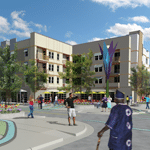The Denver Housing Authority (DHA) is pioneering the implementation of several new concepts in affordable housing. Innovations include property financing, energy efficiency and sustainability, and resident quality of life. When the DHA’s Mariposa Community Phase III is completed in 2014, the centrally located stairwell of the four-story structure makes the development a different kind of affordable housing. The stairwell becomes a more active community area through extra-wide stairs and landings, colorful walls and handrails, art, message-board walls, and landing benches.
This is just one example of broader principles applied to newer DHA buildings, which include the idea that active living fosters healthier communities. The new Mariposa building is one block from a light-rail station (Denver’s regional transportation network), and it has designated parking for bikes. The DHA incorporated community gardens in the plans, and a working urban farm is
being discussed as well. In the retail space of the recently completed first phase, Tapiz at Mariposa, a café serving healthful foods and a training center, will soon open. These amenities stem from a needs-assessment plan commissioned by the agency to address obesity, inactivity, lower access to health care, crime, lack of mobility, and underemployment in the Denver area.

The Denver Housing Authority incorporated design elements that contribute to a pedestrian-friendly urban environment, including stoops, canopies, and sitting areas. The development also meets all health-related Living Building criteria.
“Our vision and guiding principal was to go beyond LEED, to create a truly sustainable community, not just energy-efficient buildings,” says Ismael Guerrero, executive director of the DHA. So although all new construction undertaken by the agency is targeting LEED Gold or Platinum certifications, in its efforts to create “truly sustainable” communities, the DHA also is identifying other elements of vibrant neighborhoods, including art. Embracing Denver’s Santa Fe Arts District, which is adjacent to the Mariposa development, the housing authority has nonprofit arts organizations occupying ground-level commercial space while an eight-story mural and sculptures have been commissioned to give strong definition to public spaces.
The quasi-public nature of the DHA allows for this integration of the commercial and residential uses of its structures within a green context. “DHA is in a unique position,” Guerrero says. “We compete for and secure local, state, and federal capital grants. We also leverage public investment with private debt and equity to structure a mixed-finance deal that provides a public benefit and an economic return to investors. For every dollar of public investment, we leverage four or more dollars of private investment.”
Sustainable features are intrinsic to the authority’s economics. DHA is implementing a power-purchase agreement (PPA) program throughout its affordable housing portfolio on 668 existing individual units. At Mariposa, photovoltaic panels will offset 85 percent of electrical-energy demand at the facility. Other money-saving, environmentally friendly features include geothermal heating and cooling with a 7- to 11-year expected ROI; plantings, pervious pavement, and bioswales to reduce 80 percent of storm-water runoff; greywater recycling and low-flow plumbing fixtures; energy-efficient lighting; and tenant-operable, low-E windows. Plus, the site will have triple the density of what it replaces.
Mariposa, all six phases of which should be completed by 2016, also is a mixed-income development. A portion of the units are subsidized while others are provided at near-market-rate rents, roughly $750 for a one-bedroom unit and up to $1,300 for a four-bedroom townhome. “This is more financially viable,” says Guerrero. “It is a better investment of public resources.”
Many of the project’s sustainable elements, including its transit-oriented characteristics, emphasis on community engagement, and thoughtful design, came about through the counsel the DHA received from Urban Ventures, who collaborated on the master plan. “We didn’t want a repetitive, sterile-looking development,” Guerrero says, noting that Mariposa is already a model for another project-in-planning nearby.

